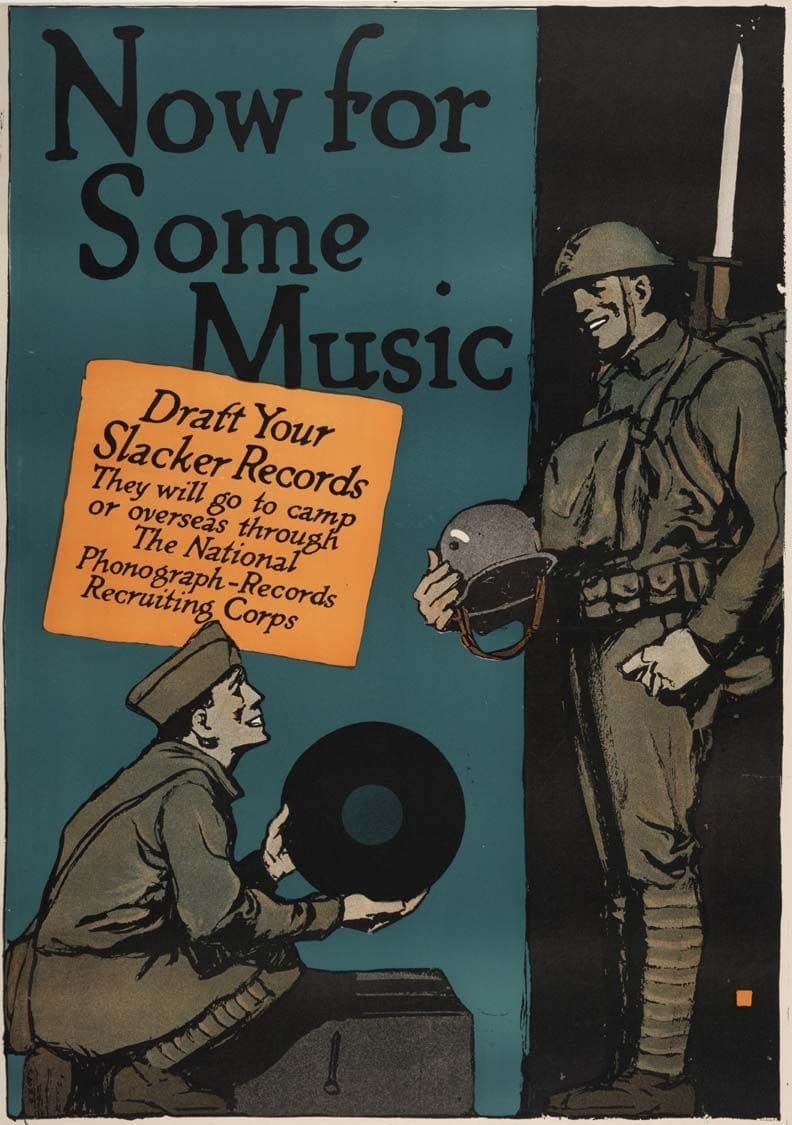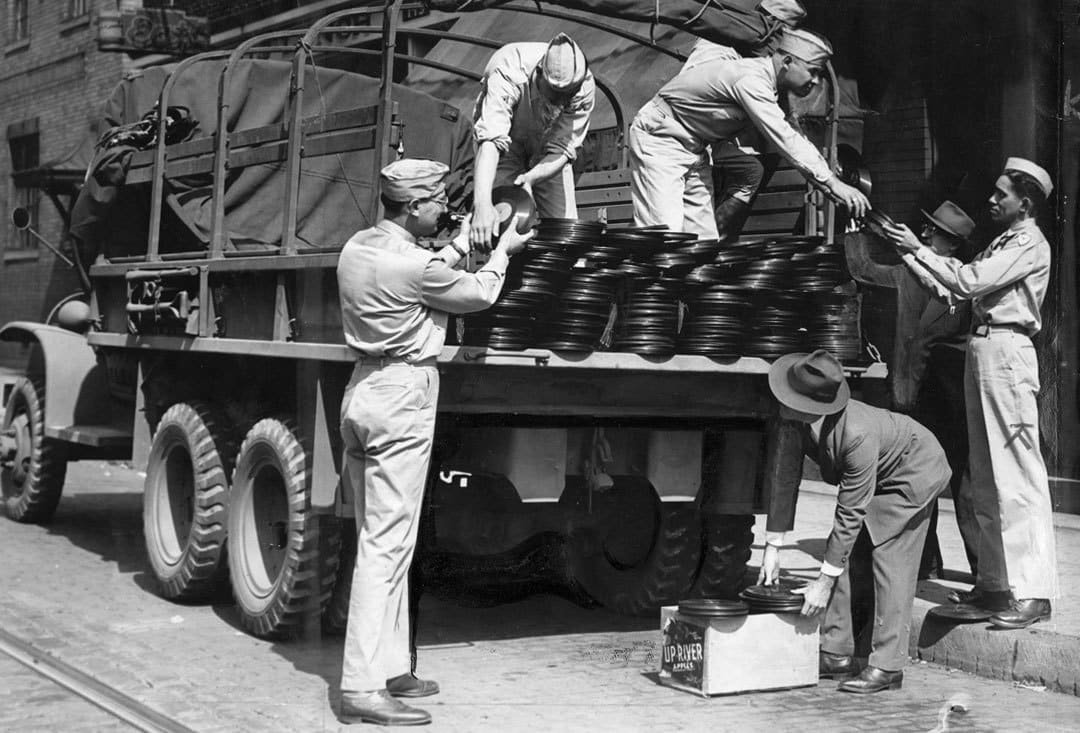The Evolution of Records: From Shellac to Vinyl
Why aren’t shellac records as common as vinyl records? When did the “fad” of vinyl take over?
We come to find out, it wasn’t actually a fad. The dramatic shift from shellac to vinyl took place out of necessity. During the early years of World War II, the demand for shellac skyrocketed. Why?
Shellac wasn’t only used to produce records full of sweet-sounding melodies. It was also used to produce explosives.
When World War II began, the War Production Board, which was the government agency responsible for supervising war production under President Franklin Roosevelt, ordered a 70 percent cut in the production of new phonograph records.
Record production consumed about 30 percent of the nation’s supply of shellac. This cut in production of shellac records was replaced with the production of signal flares and explosives, as well as artillery shell coating.
Not only was there a dramatic cut in production of shellac records, there was also a “call to arms” – if you happened to have records that were broken, chipped, or with out-of-date melodies, you would have been asked to donate them for recycling. People were also encouraged to donate their records not only to aid with weaponry, but also to “boost soldier morale.”
Photo Cred: NY Times
This effort was so far wide-spread, that there were even events based on record-donations. For example, the William Penn Hotel hosted a dance called the “War Records Dance”, where the price of admission was five disks. By 1943, the American Legion collection post counted 25,000 donated discs.
As shellac was essentially phased out, vinyl took the spotlight. It had longer playing times, was lighter, and simply became the new “thing.”
Differences in Speed: Shellac vs Vinyl (78’s vs LP’s)
Shellac/78’s
Earliest speeds of rotation varied widely, but by 1910 most records were recorded at about 78 to 80 rpm. In 1925, 78.26 rpm was chosen as a standard for motorized phonographs, because it was suitable for most existing records, and was easily achieved using a standard 3600-rpm motor and 46-tooth gear (78.26 = 3600/46).
Thus these records became known as 78s (or "seventy-eights"). This term did not come into use until after World War II when a need developed to distinguish the 78 from other newer disc record formats. Earlier they were just called records, or when there was a need to distinguish them from cylinders, disc records.
The durations of 78 RPM recordings is about three to five minutes per side, depending on the disc size. If it is a 12 inch disc, it usually holds four to five minutes of music. A ten inch typically holds three minutes.
The 78 format faded from the scene by 1955, when vinyl took over.
LP’s/Vinyls
LP is short for long play – which is characterized by a speed of 33 ⅓ revolutions per minute, and the typical speed for vinyl. Vinyls can also range in size, with the most typical sizes being 10in and 12in. The primary difference is the length of music that could be placed on each disk.
In the beginning, 12-inch LPs played for a maximum of 45 minutes, divided over two sides, with 10-inch versions carrying a maximum of 35 minutes again over two sides.
As artists started to spot the opportunities for longer playing times, this triggered the beginning of the “Album Era” of the 1960’s, where we begin to see the emergence of albums with multiple LP’s, creating a coherent theme in a single album.
A Group of Ten Bing Crosby, Decca Records, 10 in. Shellac 78s, 20th Century,
Including: 'Moonlight Becomes You, Bing Crosby' (Decca 18513); 'The Road To Morocco, Bing Crosby' (Decca 18514); 'Too-Ra-Loo-Ra-Loo-Ral, That's An Irish Lullaby, Bing Crosby' (Decca 18621); 'Mexican Rose, Bing Crosby' (Decca 2001); 'Adeste Fideles, Bing Crosby' (Decca 621); 'I Dream of Jeanie with the Light Brown Hair, Bing Crosby' (Decca 3098); 'Vict'ry Polka, Bing Crosby and The Andrew Sisters' (Decca Personality Series 23277); 'Ciribiribin, They're So In Love, Bing Crosby and The Andrew Sisters' (Decca 2800); 'Deep Purple, Bing Crosby' (Decca 2374); and 'On The Atchison, Topeka and the Santa Fe, Bing Crosby' (Decca 18690).
A Group of Four Miles Davis 12 in. Vinyl LPs from Various Labels, 20th Century
Including: 'Volume 2, Miles Davis' (Blue Note 1502); 'Legrand Jazz, Michel Legrand, featuring Miles Davis' (Columbia CL 1250); 'Miles of Jazz, Miles Davis' (Trip Jazz TLP-5015); and 'My Old Flame, Miles Davis' (Up Front UPF-171).
Spotting the Differences: Shellac vs Vinyl
Shellac is know to be heavier, harder, colder and more rigid. Hold it up by an edge and knock on it. It should almost resonate in a kind of a way. Generally a lot thicker than regular vinyl, but sometimes it's hard to tell. Also, if you drop it, it will explode. Not recommended if you want to play it again!
If you are into vintage items like records or decor items, check out our upcoming auctions for more treasures.
Stay informed about the exciting and ever-changing world of art and auctions - whether you’re a seasoned collector or just getting your feet wet. We curate & deliver the most essential & exciting art and auction news, once a week (in a way that won’t make you fall asleep.) Sign up via the form below!





